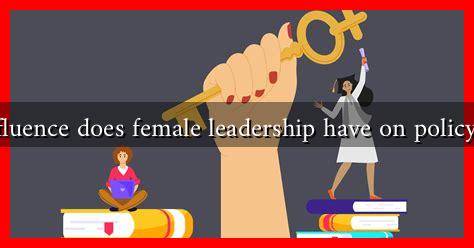-
Table of Contents
What Influence Does Female Leadership Have on Policy-Making?
In recent years, the conversation surrounding female leadership has gained significant traction, particularly in the context of policy-making. As more women ascend to leadership roles in government, corporations, and non-profit organizations, their influence on policy decisions is becoming increasingly evident. This article explores the impact of female leadership on policy-making, highlighting key areas where women leaders have made a difference, supported by relevant examples and statistics.
The Importance of Diverse Leadership
Diversity in leadership is crucial for effective policy-making. Female leaders bring unique perspectives and experiences that can lead to more comprehensive and inclusive policies. Research has shown that organizations with diverse leadership teams are more innovative and better at problem-solving. According to a McKinsey report, companies in the top quartile for gender diversity on executive teams are 25% more likely to outperform their peers in profitability.
Key Areas of Influence
Female leaders have made significant contributions to various policy areas, including:
- Health Care: Women leaders often prioritize health care policies that address women’s health issues, maternal care, and reproductive rights. For instance, Jacinda Ardern, the former Prime Minister of New Zealand, implemented policies that improved maternal health services and mental health support.
- Education: Female leaders tend to advocate for educational reforms that promote equity and access. Kamala Harris, the Vice President of the United States, has championed policies aimed at reducing student debt and increasing funding for public schools.
- Social Justice: Women in leadership positions often focus on social justice issues, including gender equality, racial equity, and LGBTQ+ rights. For example, Angela Merkel, the former Chancellor of Germany, played a pivotal role in advancing policies that supported refugees and promoted gender equality in the workplace.
- Environmental Policy: Female leaders are increasingly at the forefront of environmental policy-making. The European Commission President Ursula von der Leyen has been instrumental in pushing for the European Green Deal, which aims to make Europe the first climate-neutral continent.
Case Studies of Female Leadership in Action
Several case studies illustrate the positive impact of female leadership on policy-making:
- New Zealand’s COVID-19 Response: Jacinda Ardern’s decisive and empathetic leadership during the COVID-19 pandemic garnered international praise. Her government’s swift action and clear communication resulted in one of the lowest infection rates globally, showcasing how female leadership can effectively navigate crises.
- Rwanda’s Post-Genocide Recovery: Following the 1994 genocide, Rwanda adopted a gender quota system that led to women holding 61% of parliamentary seats. This shift has resulted in progressive policies focused on reconciliation, economic development, and women’s rights, demonstrating the transformative power of female leadership.
Statistics Highlighting the Impact of Female Leaders
Statistics further underscore the influence of female leadership on policy-making:
- According to a study by the World Economic Forum, countries with higher female representation in government tend to have better outcomes in health, education, and social welfare.
- A report from the Inter-Parliamentary Union found that countries with women in leadership roles are more likely to adopt laws aimed at combating domestic violence and promoting gender equality.
Challenges Faced by Female Leaders
Despite the positive influence of female leadership, women still face significant challenges in the political arena:
- Gender Bias: Women leaders often encounter stereotypes and biases that can undermine their authority and effectiveness.
- Work-Life Balance: The demands of leadership roles can create challenges in balancing personal and professional responsibilities, which disproportionately affects women.
- Underrepresentation: Women remain underrepresented in many political systems, limiting their ability to influence policy on a larger scale.
Conclusion
The influence of female leadership on policy-making is profound and multifaceted. Women leaders bring diverse perspectives that can lead to more inclusive and effective policies across various sectors. As demonstrated through case studies and statistics, female leadership not only enhances policy outcomes but also promotes social justice and equity. However, challenges remain, and it is crucial to continue advocating for gender equality in leadership roles to ensure that women’s voices are heard in the policy-making process. By fostering an environment that supports female leaders, societies can benefit from the unique insights and solutions they offer.
For further reading on the impact of female leadership, you can explore resources from organizations like UN Women and McKinsey & Company.


